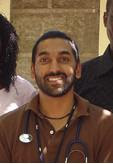I have received some complementary remarks recently while I’ve been here. Both Moline (the current clinician in PSC) and Jackson had mentioned that it would be nice if I could stay longer. Moline went so far as to recommend that I stay and work here permanently in Kenya. Of course, it would never happen, but it is nice to know that I am appreciated and that people like my work. Perhaps, they say that to everybody. I’ll pretend they don’t.
Last week, we had a tough day. The dreaded ethical decision came up. Not one, but two critically ill patients who up on our doorstep in the morning. One with a septic wound with a blood pressure of 52 systolic (that is very low and I was amazed she could walk), and the other a lady with diarrhea and a BP we couldn’t obtain. Both had no means to pay for the transport to a hospital let alone any subsequent hospital bill.
Initially, I didn’t know what to do. Joseph inquired of Management about what resources we could use for these patients. The goal of Matoso Clinic, as it should be, is to give the basic amount of care to the largest of amount of people – none of this ridiculous ICU stuff that we do in the States. However, similar to the States there are surprisingly legal implications to dropping people off at hospitals. In the case of the first patient, we needed to get her family’s consent to hospitalize her. If we did not and they didn’t want to pay for the hospital bill, apparently it’s their prerogative, and they could shift the responsibility of a multiple thousand or hundred thousand schilling bill to the Lalmba association. Plus, on that day there was a shortage of vehicles. In the end, I made the executive decision that whatever charity funds that Management was going to free up to subsidize the transport and the initial admission fee, we would use to pay for our own resource utilization. We slammed fluids and antibiotics into the patients and then gave them all their medicine free when they left the clinic. Man, what a stressful day. Resource management at its most critical, literally.
Surprisingly, one of the stories has a happy ending. The lady who came in with the septic leg, who we then discharged to walk all the way home after opening the wound so that it would drain, returned on Friday to attend the Q&A session that Joseph holds every month regarding HIV care. Amazing. It’s just a reflection of the hardiness of these Kenyan people.
Over the weekend, I learned how to drive stick shift. Daniel taught me how. Of course, I’m learning on the wrong side of the car, but hopefully I can adapt when I get to the States. The pedals are in the same order with the accelerator on the far right and the clutch on the far left. The gear shift is also in the same order. However, that means that First is furthest away from me with Reverse being closest. On a car driving on the Right side, First will be the closest and Reverse will be the furthest away. Therefore, even though the gears are in the same order conceptually, kinetically it will be the opposite, while the pedals will be the same.
Anyway, I was able to get up to 4th gear and 60 km/hr. I only stalled out twice. The main challenge was trying to get into Third. For some reason, I kept putting it back into First and we couldn’t accelerate. After we figured out the problem, I could accelerate pretty well. Daniel suggests that when we next have to transport a patient to a hospital, I can learn about what it entails to admit a patient, and then I can practice driving on the way back. I look forward to it.



No comments:
Post a Comment